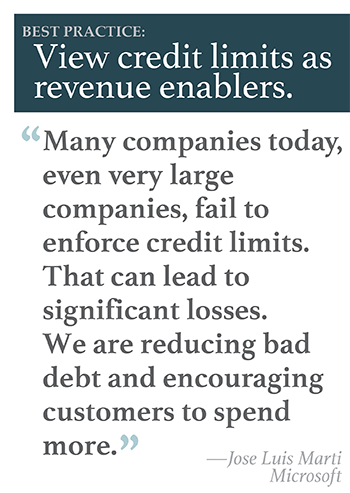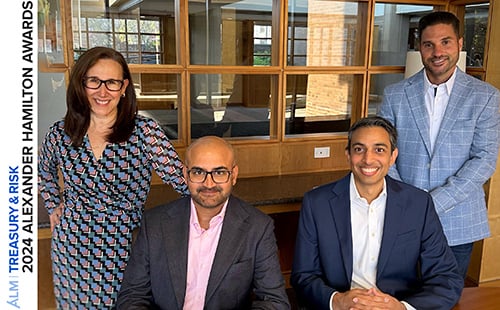
At Microsoft, advertising has become an increasingly important source of revenue over the past few years. “Our search revenue encompasses both Bing [the Microsoft search engine] and also the revenue generated through a number of syndication deals on platforms which are powered by Bing,” explains Jose Luis Marti, director of Microsoft's Worldwide Online Credit Services (WOCS) treasury team. “On our platform, we provide both display and search advertising, and in both cases it tends to be customized based on our customers' and end users' preferences.
“It's our job in the treasury team,” Marti continues, “to ensure that the number of impressions and searches a customer purchases does not exceed what they can afford to pay, which is determined by their credit limit. If we assign a credit limit of $100,000 to Company X, then they should receive only $100,000 worth of impressions or searches. Once they reach that limit, they will not receive any more advertising until they have made a payment or they secure a higher credit limit.”
When Microsoft first launched Bing, it engaged a leading Web service provider to manage the entire sales and order-to-cash processes for its large and midsize search advertising customers. However, as Bing grew and its advertising revenue became increasingly important to the overall business, Microsoft saw a strategic advantage to bringing the full management of this business in-house.
“As the Bing platform became more relevant in the marketplace, it began to face an increasing number of fraud attacks,” Marti says. “We are very risk-averse. Two years ago, we decided to end the partnership with this leading Web service provider so that we could take better control over the management of our business, which includes fraud and customer credit risk.” For this transition to work, the WOCS team needed to develop a process that would enable them to effectively, and efficiently, manage credit limits and impressions served for Microsoft's hundreds of thousands of search advertising customers around the world.
First, Marti and his team conducted a needs assessment, consulting approximately 80 stakeholders across engineering, sales, support, treasury, legal, and finance. They found some stakeholders were concerned that more rigorous management of customer credit risk would stymie sales. “It was crucial to make sure the project would not disrupt revenue in any way,” Marti says.
 The project team set three key goals for the Credit Limit Enforcement (CLE) system it was developing: increase profit margins by reducing bad debt write-offs, improve financial risk management, and simplify processes. To mitigate stakeholder concerns, they planned a phased rollout of the system, starting with a controlled sample of customers, then expanding to encompass more customers as the process proved successful.
The project team set three key goals for the Credit Limit Enforcement (CLE) system it was developing: increase profit margins by reducing bad debt write-offs, improve financial risk management, and simplify processes. To mitigate stakeholder concerns, they planned a phased rollout of the system, starting with a controlled sample of customers, then expanding to encompass more customers as the process proved successful.
Today, Microsoft's system establishes and enforces credit limits for all of the company's search advertising customers, automating as many of those processes as possible. For every new customer, either the customer or the Microsoft account manager (if the deal is generating enough revenue to merit an account manager) completes a credit application, providing financial and contact information. The system supplements this information with data from other Microsoft divisions the customer has done business with, as well as data from third parties such as external credit bureaus. Then the system applies analytics and machine learning capabilities to the compiled information, to determine the financial stability of the customer and set a credit limit.
“This all happens automatically in about 92 percent of cases,” Marti says. “The rest go for manual review, but because we have dramatically reduced the proportion requiring human intervention, we can usually assess the customer's creditworthiness within one day. If the manual review reveals a credit concern, we will offer the customer other payment options, such as prepayment, payment with a credit card, or perhaps a security deposit. We always give prospective customers an option that will allow them to do business with Microsoft.”
When the credit decision is made, the requestor—whether the customer or account manager—automatically receives an email with that information. At that point, the customer is able to start scheduling search advertising on credit, for payment after the fact.
From this point, the CLE system monitors the customer's spending on an ongoing basis. If spending approaches the established credit limit, the system may automatically reconsider that threshold. “It will take a number of factors into consideration,” Marti explains. “It will look at the customer's payment history with Microsoft and may again pull in third-party data. It will also consider when Microsoft last performed a credit review of the customer and how large the last increase was.”
The WOCS team has established rules around the amount and frequency with which credit limits can increase. If the CLE system deems a customer worthy of a higher limit and the increase abides by these rules, the system will automatically provide the customer with additional credit. “It's similar to the way credit card companies automatically increase credit limits,” Marti says. “Our goal is to help our customers spend more with Microsoft whenever possible.”
If the CLE system determines that a customer's credit limit cannot be raised, the customer and Microsoft account manager will receive email notifications as spending reaches 70 percent, 80 percent, and then 90 percent of the credit limit. When spending hits 100 percent of the credit limit, search advertising activities are automatically cut off—but they resume as soon as the customer makes a payment to bring spending back under the credit threshold.
Throughout these processes, the CLE system is monitoring all transactions for fraud. Unexpected spikes or changes in search advertising usage result in emails to the salesperson and customer. The purpose of these communications is to receive assurance from the customer that the unusual behavior is legitimate.
As a result of the CLE system, the Microsoft search advertising group was able to proactively increase customers' credit limits significantly. “The business is growing faster than it otherwise would have, because we are allowing customers to spend more,” Marti says. “If we didn't have the functionality to auto-increase credit limits, the WOCS processes might be blocking good revenue. Our goal is to identify those cases which may represent a loss in the future.”
At the same time, he adds, the system has dramatically improved the efficiency of credit and collections processes: “Now, each collections specialist can manage three to four times as many accounts as he or she could previously. Plus, the system educates customers and motivates them to pay faster. All in all, we've reduced bad debt write-offs for Microsoft's search advertising business considerably year over year, and we are well below industry norms.”
Selling the sales team on these processes initially took time, but Marti says it has been well worth the effort. “Many companies today, even very large companies, fail to enforce credit limits,” he says. “That can lead to significant losses in a consumption-based business like this one, where spending can add up very quickly. Not only are we reducing bad debt and encouraging customers to spend more, but the built-in fraud alerts, combined with the system's improved visibility into customer spending, enable us to recognize right away when we're the target of a fraud or when a customer is near insolvency. That has helped us achieve margins on our search advertising business that we believe are well above the average for the industry.”
Thus, this project has established the WOCS team as purveyors of not just credit limit enablement, but true business enablement, and it has prepared Microsoft to continue growing its market share in the search advertising sector.
See also:
And winners in our other categories of 2018 Alexander Hamilton Awards:
© Touchpoint Markets, All Rights Reserved. Request academic re-use from www.copyright.com. All other uses, submit a request to [email protected]. For more inforrmation visit Asset & Logo Licensing.



